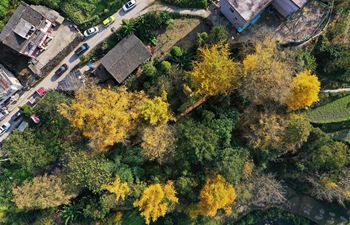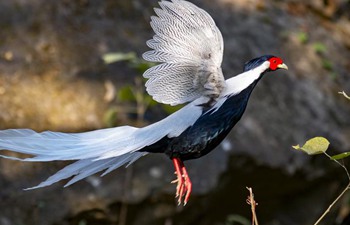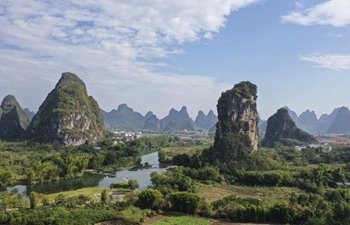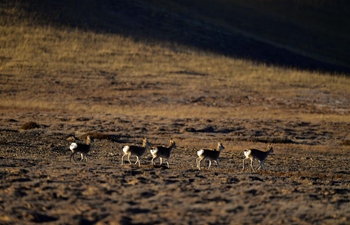by Toh Ee Ming
SINGAPORE, Nov. 15 (Xinhua) -- Wildlife photographer and documentary filmmaker Sandesh Kadur has scouted for snow leopards in high-altitude mountain ranges; navigated through grasslands tall enough to conceal elephants in Kaziranga National Park; and sat in a camouflaged grass hideout to capture a tiger feasting on a rhino carcass just meters away.
Kadur shared his stories here with Xinhua while participating in the National Geographic Explorers Festival, which was hosted in Singapore for the first time.
The festival brought together innovative scientists, conservationists, explorers, educators, storytellers, and change makers from around the world to share their discoveries, insights, and solutions for creating a more sustainable future.
These included explorers like world renowned marine biologist Sylvia Earle and conservation biologist Krithi Karanth. The festival's grand finale culminated in "An Evening of Exploration Dinner" on Friday at Marina Bay Sands.
Kadur is on a lifelong quest to bring attention to threatened species and habitats around the world. His work has appeared worldwide on the National Geographic Channel, the Discovery Channel and most recently the BBC's Planet Earth II - a nature documentary series featuring dramatic footage of wildlife in remote islands, dense jungles, deserts, epic mountain ranges, grasslands and bustling cities.
One of the most fun sequences Kadur had to film was a bachelor troupe of langurs (a type of primate) as they leapt from rooftop to rooftop of blue houses in Jodhpur city, India. It was "almost like a James Bond movie," said Kadur with a laugh.
He recently wrapped up filming for a series called "Wild Cats of India: Masters of Disguise" for National Geographic Wild. It highlights lesser-known facts, like how India has more species of wild cats than anywhere else in the world - numbering at 15 species, in fact.
Kadur believes that films and images have a tremendous power to create awareness, inspire the young and spark policy change towards wildlife conservation.
"The message that I always (share to) people is a quote I read a long time ago, that in the end we will conserve when we love. We love only what we understand ... So my job is show things that people may not know about, make them fall in love and want to care about it," said Kadur.
Kadur recalled the extraordinary sight of langurs at the temple grounds of Mandore Gardens in Jodhpur co-existing with humans, while on a previous shoot.
Pointing to how the concept of "wild cities" and conscious development becomes increasingly more important, he said, "We've taken a lot of their space ... So I think if people can just give back with patience and tolerance, there's plenty of space to allow animals to live alongside us."
Speaking to Xinhua, Earle believes that there is no better time than now to take action.
A National Geographic Society explorer-in-residence who has been named one of Time magazine's "Heroes for the Planet," Earle has dedicated her entire life to being a voice for the ocean.
People now realize that the earth is in trouble and are "only now beginning to understand what it takes to make habitable planet," said the 84-year-old biologist.
Part of the wakeup call came 50 years ago, when, for the first time, "there were people up in the sky in space, looking back, and seeing this little blue miracle, this blue ocean planet" and realising how vulnerable this life support system is, she said.
People need to continue to have hope and believe they can "make a difference before it is too late", and more importantly, take action to "change the trajectory of decline," she said.
In 2009, Earle founded non-profit organisation Mission Blue, which aims to safeguard protected marine areas which are critical to the health of the oceans. There are 130 of these Hope Spots today, but it is still not enough, said Earle.
Today, the Pacific bluefin tuna has whittled down to less than 3 percent of the original amount in the 1970s, all because of "marketing which has created an appetite for it which did not exist 50 years ago," she said.
"What we now know is that the ocean keeps us alive, literally every breath we take every drop of water we drink, we're connected to the ocean. And it doesn't matter where on earth you live, whether you've never touched the ocean or seen the ocean, the ocean touches you," she said.
"And if you can just understand that and then embrace it ... We need to take care of the ocean, because it keeps us alive."













